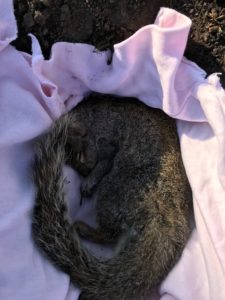Saturdays with Seniors: Ann, That Crazy Squirrel Lady
January 9, 2021 • 18 Comments • Posted in guest blog, memoir writingI am pleased to feature Ann Parrilli as our Saturdays with Seniors guest blogger today. Ann joined the “Me, Myself and I” class last year when we were still meeting in person at the Chicago Cultural Center and continues writing — and reading — essays while that class meets via Zoom. Here she is with an essay about a city creature who stole her heart.
by Ann Parrilli
I was clipping along on my daily walk when I saw, maybe 10 yards ahead of me, what looked like a hat on the sidewalk. A wrought iron fence ran along the left side of the walk — I’d be able to hang the hat there so the owner would see it the next time he or she passed by. I was almost on top of the object when I realized it was not a hat.
It was a dead squirrel.
My first instinct was to move it off the sidewalk so it wouldn’t be set upon by a dog looking for a playmate or, worse, a coyote looking for a tasty appetizer.
I did not have my latex Covid gloves with me at the moment, so my overriding second instinct was to play it safe and not touch it. I paused long enough to appreciate how the color and texture of its fur blended into the sidewalk in an uncanny composition of man and nature.
I walked on with that picture in my head. Twenty yards on, I turned back. Feeling foolish, and a little heartless, I pulled out my phone and took a picture of this arresting still life. He was a beautiful specimen. I knelt down on one knee to look closer. He looked well fed, with a thick and glossy coat. His closed eyes were bordered by feathery eyelashes that matched his variegated coat , a rich mixture of grey, white and amber. His ears were erect, ready to detect any danger. His back legs were muscular and flexed. It was as if he had fallen while still intent on landing on a branch just slightly out of reach.
I must have been there close to the ground quite a while. When I tried to stand up, I had to unfold myself in sections. An hour later I was startled to find myself at my front door. How did I get there? I don’t remember anything about that part of my walk. My mind was elsewhere.
Throughout the evening I would occasionally look at the picture I’d taken that late afternoon. He really was a beautiful creature. I slept fitfully that night, and by the time daylight crept into my room I gave up trying to rest. I knew what I had to do.
After gathering gloves, trowel, a low stool and remnants of a soft cotton sweatshirt I used to wear in my underheated San Francisco apartment, I resigned myself to be forever known in my neighborhood as “that crazy squirrel lady” and set off pulling my cart behind me.
The morning was pleasantly still and sunny, the kind of day that makes everything a bit easier. Arriving at the site, I found my furry friend lying peacefully under his tree. A kinder person than myself had moved him off the sidewalk to the comfort of grass and fallen leaves. What a relief to see he had not been disturbed by a predator.
It didn’t take long to dig deep enough. After lining his grave with my shirt, I gently lifted him into his forever home. He curled gracefully into the contours of the walls, much like, I imagined, he would have in his own nest. He looked at peace.
And, finally, so was I.




